Technical mountain biking has surged in popularity across the United States, attracting riders seeking thrilling challenges. California, often considered the birthplace of modern mountain biking culture, has played a pivotal role in shaping this sport. Trails like Downieville Downhill and Repack Road have become benchmarks for those looking to test their skills.
This guide focuses on routes that demand technical expertise and commitment. From the rugged terrains of California to the wild landscapes of Alaska, and even lesser-known gems in the Midwest, there’s something for every advanced rider. Whether you’re an experienced enthusiast or looking to push your limits, these trails offer unforgettable experiences.
Table of Contents
Key Takeaways
- Technical mountain biking is growing in popularity across the U.S.
- California is a key player in the sport’s culture and history.
- Iconic trails like Downieville Downhill set high standards.
- This guide highlights trails requiring advanced skills.
- Coverage spans from California to Alaska and the Midwest.
What Makes a Trail Ideal for Advanced Mountain Bikers?
The best routes for skilled cyclists combine elevation, terrain, and demanding features. These paths are designed to test endurance, precision, and commitment. Whether it’s steep descents or rugged surfaces, the right trail offers a thrilling challenge.
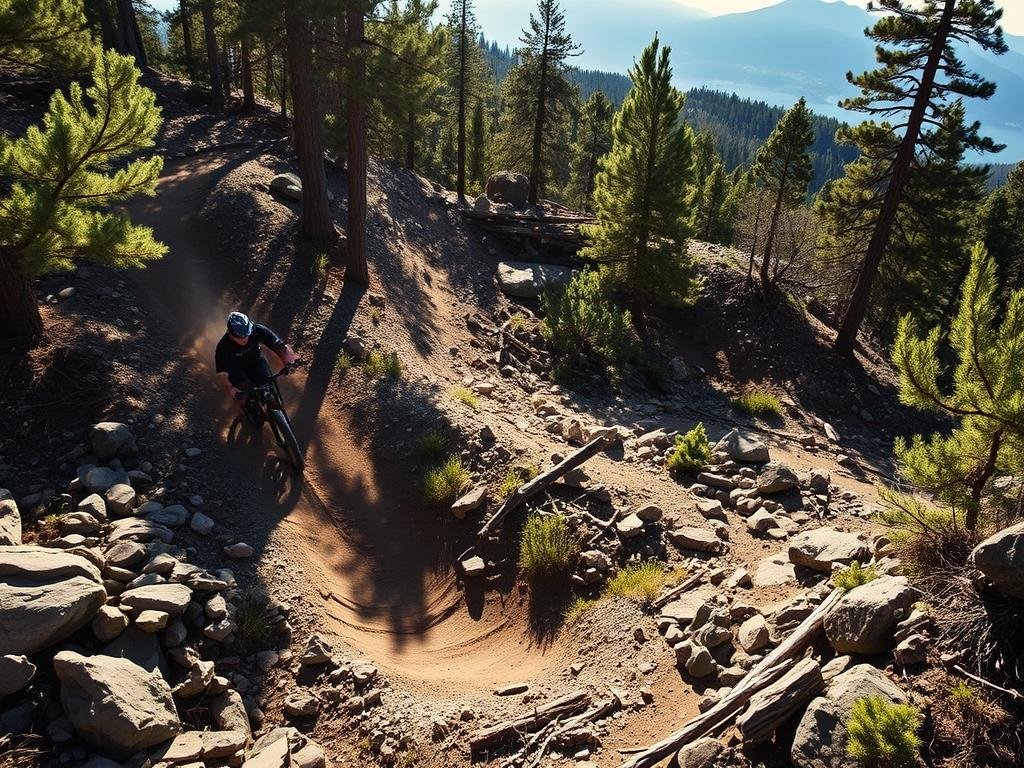
Technical Features to Look For
Advanced trails often include sustained rock gardens over 100 feet long. These sections require focus and control. Mandatory drops exceeding 18 inches are another hallmark. These features demand full commitment and skill.
Other elements include exposed granite slabs, root webs, and embedded babyheads. These terrain types add complexity and excitement. For example, Black Lead’s 3-foot vertical drops are a test of courage and technique.
Elevation and Terrain Challenges
Elevation plays a crucial role in defining a trail’s difficulty. Descents of 2,000 feet or more with sustained gradients of 15%+ are common. These routes push physical and mental limits.
California’s Cannell Plunge is a benchmark with a 5,094-foot descent. Its mix of rocky surfaces and flow sections makes it a must-ride. Such elevation profiles ensure a memorable experience.
When choosing a trail, consider the features and terrain that match your skill level. These elements create the ultimate challenge for advanced cyclists.
Mountain Biking Trails for Advanced Riders in California
California’s diverse landscapes offer some of the most challenging and rewarding routes for skilled cyclists. From steep descents to technical creek crossings, these trails are designed to push your limits. Whether you’re tackling Sierra granite or Coastal Range loam, the terrain demands precision and focus.
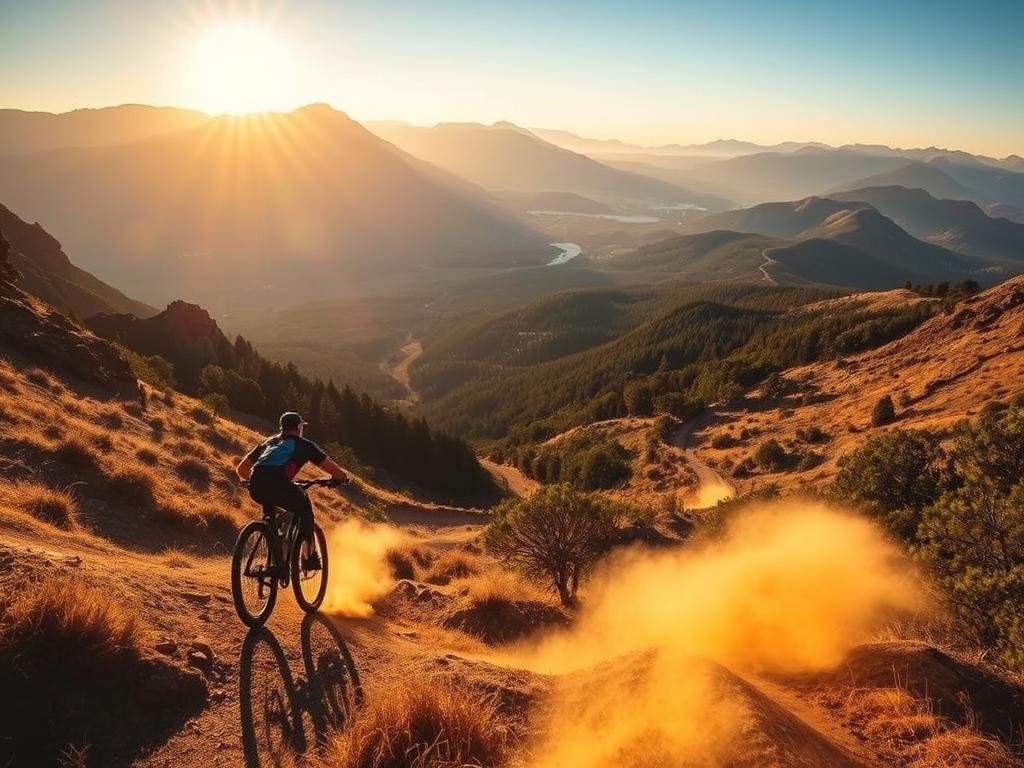
Downieville Downhill: A Legendary Descent
Downieville Downhill is a 15-mile route with a 4,915ft descent, making it a benchmark for downhill mountain enthusiasts. It’s part of a 7-trail network that includes Gold Valley Rim Trail and Big Boulder Trail. Shuttle services like Big Boulder Adventures and Yuba Expeditions make access seamless.
These services transport riders from Downieville to Packer Saddle, offering a stress-free start to your adventure. Reservations are recommended, especially during peak seasons.
Nelson Trail: Creek Crossings and Steep Drops
Nelson Trail features 11 creek crossings, some requiring dismounts, and a 2,289ft descent. The trail’s technical sections demand focus and skill. For detailed insights, consult local guides or the Sierra Buttes Trail Stewardship.
This trail is perfect for those who enjoy a mix of water crossings and steep drops. It’s a true test of endurance and technique.
Black Lead: Commitment-Required Singletrack
Black Lead is a one-way singletrack with a 221ft descent and no-bail zones. Its extreme exposure requires full commitment. Always check local guidelines before riding.
This trail is not for the faint-hearted. It’s a high-consequence route that rewards skilled riders with an unforgettable experience.
| Trail | Descent | Key Features |
|---|---|---|
| Downieville Downhill | 4,915ft | 7-trail network, shuttle services |
| Nelson Trail | 2,289ft | 11 creek crossings, steep drops |
| Black Lead | 221ft | One-way, extreme exposure |
When riding these trails, safety gear is essential. Helmets, knee pads, and gloves are a must. For more details on California’s iconic routes, visit this guide.
Top Lift-Served Bike Parks in the US
Lift-served bike parks are revolutionizing the way cyclists experience downhill thrills. These parks offer unparalleled convenience, allowing riders to focus on the ride rather than the climb. From the West Coast’s expansive views to the East Coast’s technical challenges, each region brings its own flavor to the bike park experience.
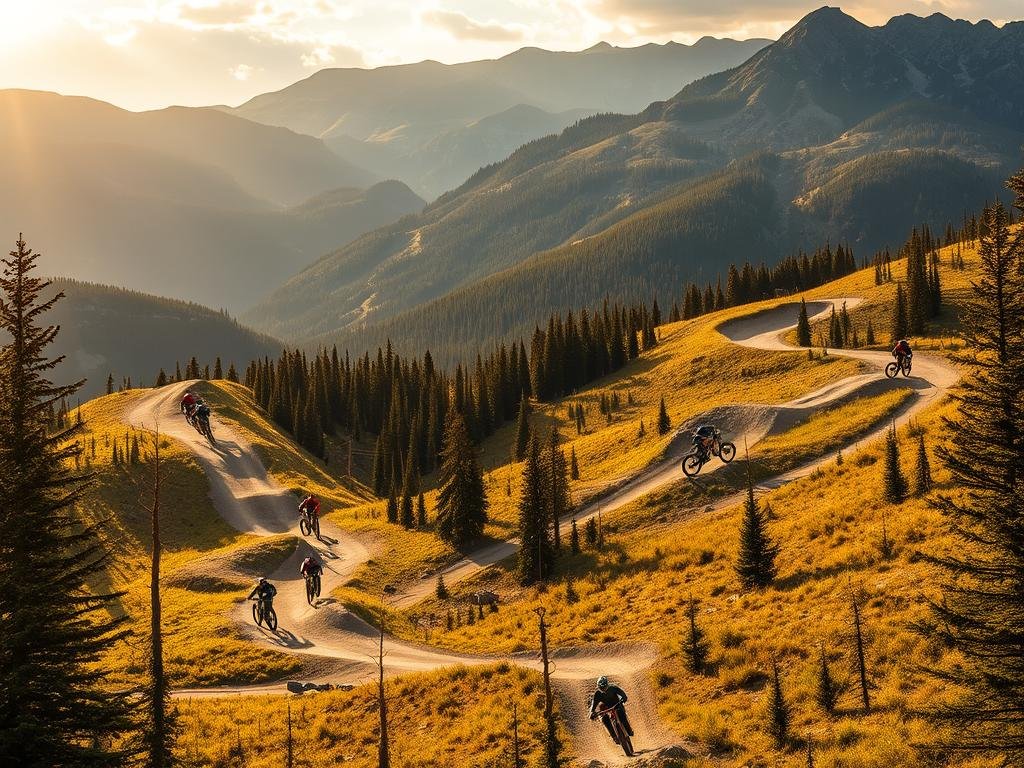
Mammoth Mountain Bike Park: 80+ Miles of Thrills
Mammoth Mountain Bike Park in California is a standout destination with over 80 miles of trails. Its unique pumice terrain requires specialized tires for better grip and control. The park’s 3,100ft vertical drop ensures a heart-pounding descent for even the most seasoned riders.
West Coast parks like Mammoth emphasize smooth singletrack and long descents, offering a diverse riding experience. For those visiting, booking shuttle services in advance can help avoid summer crowds and maximize riding time.
Trestle Bike Park: Colorado’s Downhill Playground
Trestle Bike Park at Winter Park Resort is a haven for downhill enthusiasts. With a 2,680ft drop and 40+ miles of trails, it caters to all skill levels. The park’s progression system, from the beginner-friendly Flow State line to the advanced Rain Maker, ensures riders can build their skills confidently.
East Coast parks, in contrast, focus on technical features like roots and rocks, making Trestle’s approach a refreshing blend of both philosophies. For those without their own gear, the park offers premium bike rentals with 200mm+ travel, perfect for tackling its demanding terrain.
| Bike Park | Vertical Drop | Key Features |
|---|---|---|
| Mammoth Mountain | 3,100ft | Pumice terrain, 80+ miles |
| Trestle Bike Park | 2,680ft | Progression system, 40+ miles |
Whether you’re drawn to the West Coast’s expansive trails or the East Coast’s technical challenges, lift-served bike parks offer something for every downhill enthusiast. Plan ahead, gear up, and get ready for an unforgettable ride.
California’s Iconic Advanced Trails
California’s rugged terrains are home to some of the most iconic and challenging routes for skilled cyclists. These trails blend technical features with breathtaking scenery, offering a mix of adrenaline and adventure. Two standout routes, Cannell Plunge and Repack Road, have become benchmarks for their unique challenges and historic significance.
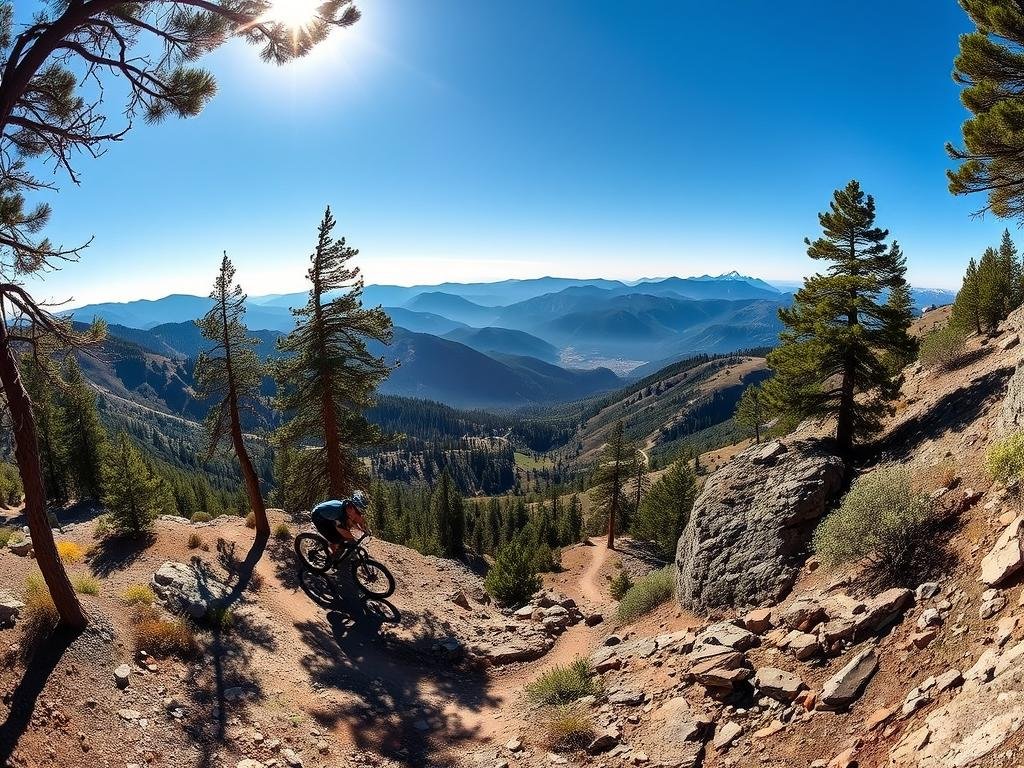
Cannell Plunge: Rocky Descents and Flow
Cannell Plunge is a legendary route known for its 5,094-foot descent. The trail alternates between technical zones with rock gardens and smooth flow sections, making it a favorite among experienced riders. Its rocky surfaces demand precision, while the flow sections provide a chance to catch your breath.
Seasonal access is limited to May through November, ensuring optimal conditions. E-bikes are restricted on this heritage trail, preserving its traditional appeal. Modern bike technology has made the ride smoother, but the trail’s essence remains unchanged since its inception.
Repack Road: Birthplace of Mountain Biking
Repack Road holds a special place in cycling history as the birthplace of the sport. Its original 1976 race course featured a 1,277-foot drop with a 10% average gradient. Riders on vintage brakeless rigs faced immense challenges, setting the stage for modern mountain bike trails.
Today, the trail remains a test of skill and endurance. Comparing modern bikes to 1970s technology highlights the sport’s evolution. Repack Road’s historic legacy continues to inspire riders worldwide.
| Trail | Descent | Key Features |
|---|---|---|
| Cannell Plunge | 5,094ft | Rock gardens, flow sections |
| Repack Road | 1,277ft | Historic route, 10% gradient |
Whether you’re drawn to Cannell Plunge’s technical challenges or Repack Road’s historic allure, these trails offer unforgettable experiences. Plan your visit during the May-November window for the best conditions.
East Coast Gems for Advanced Riders
The East Coast offers a mix of technical trails and bike parks that challenge even the most skilled cyclists. From the rugged Appalachian granite to the Southern clay textures, these destinations provide diverse terrains and thrilling experiences. Two standout locations, Powder Ridge Bike Park and Jarrod’s Place, are perfect for those seeking high-adrenaline descents and unique features.
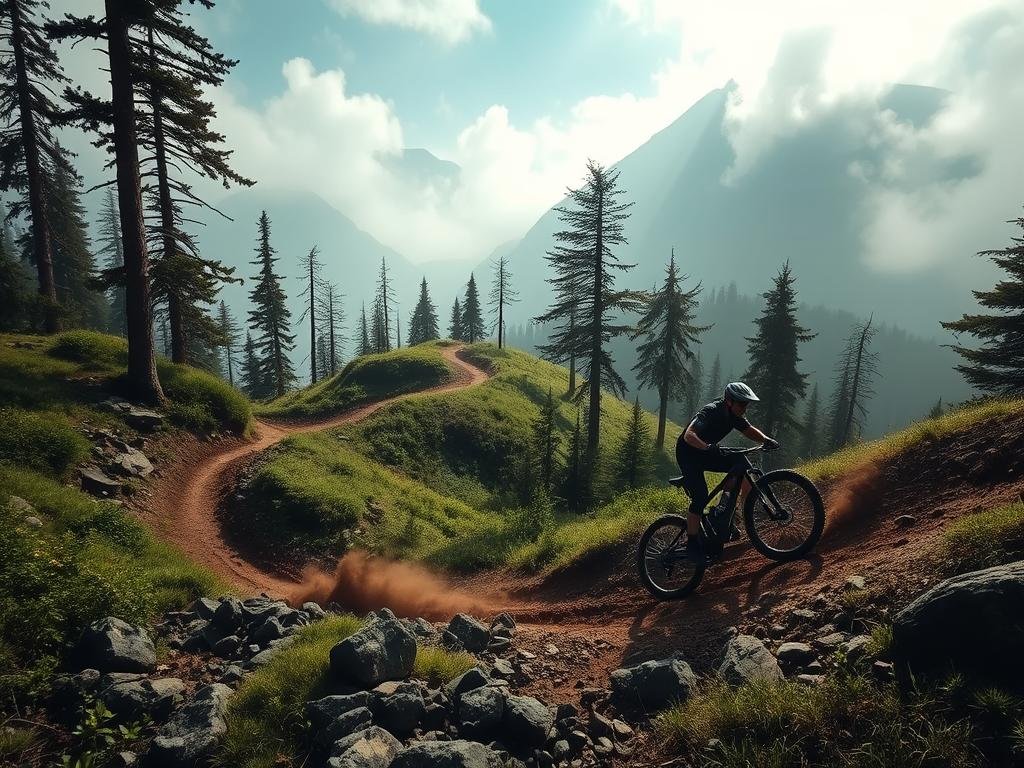
Powder Ridge Bike Park: Connecticut’s Hidden Challenge
Powder Ridge Bike Park is a hidden gem in Connecticut, offering a 419-foot vertical drop. Its artificial rock gardens and progressive drop lines make it ideal for riders looking to hone their skills. The park’s design focuses on creating a balance between technical challenges and flow, ensuring a rewarding experience for all levels.
Seasonal considerations are key here. Summer humidity can make the trails slick, while fall offers prime riding conditions. The park’s layout encourages progression, making it a great spot for both practice and competition.
Jarrod’s Place: Georgia’s Premier Bike Park
Jarrod’s Place in Georgia is a must-visit for enthusiasts seeking a 745-foot drop with pro-level lines. Its efficient shuttle system allows riders to maximize their time on the 6-mile descent, repeating runs without the hassle of climbing. The park’s terrain includes a mix of natural and man-made features, offering a dynamic riding experience.
The Southeast’s emerging enduro race scene has put Jarrod’s Place on the map. Riders can test their skills against challenging courses while enjoying the region’s unique clay textures. Fall is the best time to visit, with cooler temperatures and optimal trail conditions.
| Bike Park | Vertical Drop | Key Features |
|---|---|---|
| Powder Ridge | 419ft | Artificial rock gardens, drop progression |
| Jarrod’s Place | 745ft | Shuttle system, pro lines |
Whether you’re drawn to the technical challenges of Powder Ridge or the high-speed descents at Jarrod’s Place, these East Coast bike parks offer something for every advanced rider. Plan your visit during the fall for the best conditions and an unforgettable experience.
Rocky Mountain High: Colorado’s Best Advanced Trails
Colorado’s rugged landscapes are a playground for cyclists seeking high-altitude thrills. With trailheads often exceeding 9,000 feet, riders must acclimate to the thin air before tackling these demanding routes. The state’s bike parks and trails are renowned for their technical features, stunning scenery, and challenging elevation profiles.
Keystone Bike Park: Raw and Rugged Terrain
Keystone Bike Park offers a 2,303-foot drop, blending natural and machine-built features. The park’s raw terrain includes rocks, steep descents, and technical sections that test even the most skilled riders. Its design balances challenging elements with flow, making it a favorite for those seeking a mix of adrenaline and control.
Riders should prepare for the park’s high-altitude conditions. Proper hydration and acclimation are essential. Tire selection is also crucial, as Colorado’s sharp granite shards demand durable treads for optimal grip.
Vail Mountain Bike Park: Scenic and Technical
Vail Mountain Bike Park spans 63 miles with a 2,214-foot descent. Its trails wind through breathtaking backcountry, connecting to adjacent wilderness areas. The park’s technical sections, including root webs and rocks, provide a thrilling challenge for advanced riders.
High-alpine weather can change rapidly, so riders should pack layers and rain gear. The park’s scenic views and diverse terrain make it a must-visit for those exploring Colorado’s downhill offerings.
| Bike Park | Vertical Drop | Key Features |
|---|---|---|
| Keystone | 2,303ft | Natural and machine-built terrain, sharp rocks |
| Vail | 2,214ft | Backcountry connectors, technical sections |
Whether you’re drawn to Keystone’s rugged terrain or Vail’s scenic trails, Colorado’s bike parks offer unforgettable experiences. Plan ahead, gear up, and embrace the challenge of high-altitude riding.
Pacific Northwest Adventures
The Pacific Northwest is a haven for cyclists seeking diverse terrains and thrilling descents. From volcanic rock formations to sedimentary trails, the region offers a unique riding experience. Its lush forests and dramatic landscapes make it a standout destination for those looking to push their limits.
Silver Mountain Bike Park: 3,400 Feet of Vertical
Silver Mountain Bike Park boasts the longest gondola in the U.S., stretching 3.1 miles. This feature allows riders to access a continuous descent of 3,400 feet, making it a must-visit for thrill-seekers. The park’s trails are carved into volcanic rock, offering a rugged and technical ride.
Riders can choose from multiple routes, each designed to test their skills. The park’s elevation and terrain create a challenging yet rewarding experience. Whether you’re tackling steep drops or navigating rocky sections, Silver Mountain delivers an unforgettable adventure.
Schweitzer Mountain: Lake Views and Flow Trails
Schweitzer Mountain offers a 1,548-foot drop with stunning views of Lake Pend Oreille. Its flow trails are designed for speed and smooth riding, featuring berm networks that wind through the forest. These trails are perfect for those who enjoy a mix of technical challenges and scenic beauty.
The terrain here is a mix of sedimentary rock and loam, providing excellent grip and a unique riding experience. Schweitzer’s trails are ideal for riders looking to improve their skills while enjoying the region’s natural beauty.
Key Considerations for the Pacific Northwest:
- Volcanic rock trails are rugged and technical, while sedimentary trails offer smoother rides.
- The best time to visit is between July and September, when weather conditions are optimal.
- Bear safety protocols are essential for backcountry connectors. Carry bear spray and stay alert.
Whether you’re drawn to Silver Mountain’s vertical drops or Schweitzer’s flow trails, the Pacific Northwest offers something for every cyclist. Plan your trip during the summer months for the best conditions and an unforgettable experience.
Southern California’s Bike Park Duo
Southern California’s bike parks offer a unique blend of machine-built features and natural terrain. Snow Summit and Snow Valley stand out as premier destinations for riders seeking thrilling descents and versatile trails. Whether you’re a beginner or a seasoned pro, these parks provide an unforgettable experience.
Snow Summit: Machine-Built Berms and Jumps
Snow Summit is renowned for its Gravity Logic-designed features, including World Cup-level jump lines and perfectly sculpted berms. With a 1,158-foot drop, this park offers a mix of technical challenges and smooth flow sections. Riders can test their skills on advanced trails while enjoying the park’s meticulously crafted terrain.
The park’s machine-built elements ensure consistency and safety, making it a favorite among downhill enthusiasts. Seasonal closures during the SoCal fire season are common, so plan your visit accordingly. Shuttle services from the LA metro area make access convenient for riders.
Snow Valley: Pro Lines and Beginner-Friendly Flow
Snow Valley offers a 849-foot vertical drop with a dual progression system. Advanced riders can tackle pro-level lines, while beginners enjoy smooth flow trails. The park’s natural terrain contrasts with Snow Summit’s machine-built features, providing a diverse riding experience.
Shuttle services are available, ensuring riders can maximize their time on the trails. Snow Valley’s versatility makes it an ideal choice for groups with varying skill levels. Check local guidelines for updates on trail closures during fire season.
| Bike Park | Vertical Drop | Key Features |
|---|---|---|
| Snow Summit | 1,158ft | Machine-built berms, World Cup jumps |
| Snow Valley | 849ft | Pro lines, beginner-friendly flow |
Whether you’re drawn to Snow Summit’s technical challenges or Snow Valley’s versatile trails, Southern California’s bike parks deliver an exceptional riding experience. Plan your visit during optimal seasons and take advantage of shuttle services for a seamless adventure.
Alaska’s Alyeska Bike Park: Wilderness Riding
Alaska’s Alyeska Bike Park offers a raw and untamed experience, blending rugged terrain with the thrill of wilderness riding. Located in Girdwood, this park features a 1,348-foot vertical drop, making it a must-visit for those seeking high-adrenaline descents. Its unique glacial till soil composition adds an extra layer of challenge, requiring precise skills and focus.
One of the park’s standout features is the midnight sun, allowing riders to enjoy extended daylight hours during summer. This natural phenomenon creates a surreal experience, with trails illuminated well into the night. However, riders must be prepared for the region’s wildlife. Bear spray is essential, and proper protocols should always be followed.
Crossing alpine tundra requires specific bike setups. Wider tires with aggressive treads are recommended for better grip on the uneven terrain. Suspension adjustments can also enhance control during descents. These preparations ensure a safe and enjoyable ride through the park’s diverse trails.
Every September, Alyeska hosts a festival featuring big mountain lines. This event attracts riders from across the country, offering a chance to test their skills on challenging routes. The festival’s vibrant atmosphere and breathtaking scenery make it a highlight of the bike park season.
| Feature | Details |
|---|---|
| Vertical Drop | 1,348ft |
| Unique Terrain | Glacial till soil, alpine tundra |
| Special Event | September festival with big mountain lines |
Whether you’re drawn to the park’s rugged wilderness or the thrill of its descents, Alyeska Bike Park delivers an unforgettable experience. Plan your visit during the summer months to take full advantage of the midnight sun and festival events.
Arkansas’ Hidden Downhill Trails
Arkansas’ hidden trails offer a unique blend of technical challenges and scenic beauty, perfect for those seeking an adrenaline rush. From the Ozark quartzite formations to the Southern hospitality, these trails provide an unforgettable experience for skilled cyclists.
Lake Leatherwood Gravity Project
Lake Leatherwood Gravity Project features a 372-foot drop with seven dedicated downhill lines. These trails are known for their massive berms and technical features, making them a favorite among experienced riders.
The Ozark quartzite terrain adds an extra layer of difficulty, requiring precision and focus. Riders can expect a mix of fast descents and challenging rocks, ensuring a thrilling ride.
Buffalo River Outdoor Center
Buffalo River Outdoor Center boasts a 1,300-foot descent, offering one of the longest downhill experiences in the region. Its dual shuttle system ensures riders can maximize their time on the trails without the hassle of climbing.
The center’s Southern hospitality extends to its amenities, including bike rentals and guided tours. The terrain here is often compared to the Appalachian trails, providing a similar level of challenge and excitement.
Whether you’re drawn to Lake Leatherwood’s technical features or Buffalo River’s long descents, Arkansas’ trails deliver an exceptional riding experience. Plan your visit to explore these hidden gems and push your limits.
Idaho’s Must-Ride Advanced Trails
Idaho’s rugged landscapes are a haven for cyclists seeking technical challenges and scenic beauty. The state’s trails, carved into the Sawtooth Range, offer a mix of granite slabs and flowy singletrack. Whether you’re tackling steep descents or navigating rocky sections, Idaho’s trails deliver an unforgettable experience.
Brundage Mountain: Progression-Focused Terrain
Brundage Mountain features a 1,555-foot drop with stepped progression lines. These trails are designed to help riders build their skills gradually. The terrain includes a mix of technical sections and smooth flow zones, making it ideal for those looking to improve their technique.
The Sawtooth Range’s granite slabs require precise handling. Riders should focus on maintaining balance and control. Brundage’s trails also offer stunning views of the surrounding mountains, adding to the overall experience.
Sun Valley: Scenic Flowy Singletrack
Sun Valley is known for its 2,158-foot descent through aspen groves. The trails here are fast and flowy, perfect for high-speed runs. The singletrack winds through dense forests, offering a mix of technical challenges and scenic beauty.
Wildfire smoke can be a concern during the summer months. Riders should check local air quality reports before heading out. For those planning an extended stay, backcountry yurts provide a unique lodging option.
| Trail | Vertical Drop | Key Features |
|---|---|---|
| Brundage Mountain | 1,555ft | Stepped progression lines, granite slabs |
| Sun Valley | 2,158ft | Flowy singletrack, aspen groves |
Whether you’re drawn to Brundage’s technical terrain or Sun Valley’s scenic singletrack, Idaho’s trails offer something for every advanced rider. Plan your visit during the summer for the best conditions and an unforgettable adventure.
Midwest Surprises for Advanced Riders
The Midwest offers unexpected gems for cyclists seeking thrilling challenges. While often overlooked, this region boasts technical trails and unique terrain that rival more famous destinations. Illinois’ newest addition, Farside Bike Park, is a prime example of what the Midwest has to offer.
Farside Bike Park: Illinois’ Newest Addition
Opened in 2022, Farside Bike Park features a 475-foot vertical drop carved into glacial moraine soil. This terrain composition adds a unique challenge, requiring precise handling and focus. The park’s artificial rock gardens are a standout feature, designed to test even the most skilled riders.
The Mississippi River Valley’s weather patterns also play a role in shaping the riding experience. Seasonal changes bring varying conditions, from slick trails in spring to dry, fast tracks in summer. These factors make Farside a dynamic destination for cyclists.
In terms of difficulty, Farside’s trails are often compared to the Appalachian Trail. Both demand endurance and technical skill, but Farside’s features offer a distinct Midwest flavor. Riders can expect a mix of steep descents, tight turns, and challenging obstacles.
For those looking to compete, the region hosts several enduro series events throughout the year. These races attract top talent and provide an opportunity to test skills on Farside’s demanding trails.
| Feature | Details |
|---|---|
| Vertical Drop | 475ft |
| Terrain | Glacial moraine soil, artificial rock gardens |
| Difficulty | Comparable to Appalachian Trail |
| Events | Regional enduro series |
Whether you’re drawn to its unique terrain or the thrill of its descents, Farside Bike Park is a must-visit for advanced cyclists. Plan your trip to experience this Midwest gem and push your limits.
Essential Gear for Advanced Mountain Biking
Selecting the right equipment is crucial for tackling demanding routes with confidence. Advanced cycling requires specialized gear to handle diverse terrains and conditions. From helmets to tire inserts, each piece plays a vital role in ensuring safety and performance.
Full-face helmets and enduro lids cater to different riding styles. Full-face helmets are heavier but offer superior impact protection, ideal for high-speed descents. Enduro helmets, on the other hand, are lighter and better ventilated, suited for mixed uphill and downhill sections.
Tire insert systems are essential for protecting against sharp rocks. These systems enhance durability and reduce the risk of punctures, ensuring a smoother ride on rugged trails. Consulting specialized resources can help you choose the right system for your needs.
Brake pad selection varies by terrain. Semi-metallic pads are excellent for high-speed descents due to their heat resistance. Ceramic pads offer low noise levels but may lack stopping power. For heavy-duty applications, low-metallic NAO pads provide enhanced heat dissipation.
Suspension setup charts tailored to different regions can optimize your ride. These charts help adjust your bike’s suspension for specific terrain types, ensuring better control and comfort. Local bike shops or manufacturer guidelines are valuable resources.
Emergency satellite communicators are indispensable for backcountry adventures. Devices like the Garmin inReach Mini 2 offer two-way messaging and location tracking, ensuring safety in remote areas. Personal Locator Beacons (PLBs) provide direct links to rescue services without subscriptions.
| Gear | Usage |
|---|---|
| Full-face Helmets | High-speed descents, superior protection |
| Tire Inserts | Protection against sharp rocks |
| Semi-metallic Brake Pads | Heat resistance for high-speed descents |
| Satellite Communicators | Backcountry safety and communication |
Investing in the right gear enhances your skills and ensures a safer, more enjoyable experience on challenging trails. Whether you’re navigating rocky paths or remote backcountry, the right equipment makes all the difference.
Planning Your Advanced Mountain Biking Trip
Planning an advanced cycling trip requires careful preparation to maximize your experience. From choosing the right time to understanding transportation options, every detail matters. This guide will help you navigate seasonal considerations and optimize your rides with shuttle and lift pass tips.
Seasonal Considerations
Timing your trip around the best season is crucial. For example, the Pacific Northwest offers prime conditions from July to September, while the Southwest is ideal in spring and fall. Regional weather patterns can significantly impact trail conditions and accessibility.
Analyzing these patterns ensures you avoid extreme weather or overcrowded trails. For instance, wildfire smoke in Idaho during summer can affect air quality, while fall in Georgia provides cooler temperatures and optimal riding conditions.
Shuttle and Lift Pass Tips
Efficient transportation is key to maximizing your rides. Shuttle services, like those at Downieville Downhill, eliminate the hassle of climbing, allowing you to focus on the descent. Similarly, lift-served parks, such as Mammoth Mountain, offer seamless access to thrilling trails.
Consider the Loam Pass, which grants access to 60+ parks with two free days each. This pass is a cost-effective option for multi-resort road trips. Calculate its benefits based on your itinerary to determine if it’s worth the investment.
When deciding between bike rentals and shipping, evaluate your time and budget. Renting locally can save on shipping costs, while bringing your own bike ensures familiarity with your gear. Additionally, research mechanical service locations along your route for peace of mind.
By considering these factors, you can plan a seamless and unforgettable adventure. Whether you’re exploring the rugged terrains of Alaska or the technical trails of Arkansas, preparation is the key to success.
Why Advanced Riders Should Explore These Trails
Exploring challenging routes can elevate your technical expertise and push your limits. These trails are designed to test your skills while offering opportunities for progression. Whether you’re aiming to transfer your abilities to race environments or simply enjoy the thrill, these routes deliver unmatched experiences.
One of the key benefits is exposure to diverse geological formations. Each trail presents unique terrain, from rocky descents to flowy singletrack. This variety not only enhances your adaptability but also keeps the experience fresh and exciting.
Community building is another significant advantage. Regional styles and shared challenges foster connections among advanced riders. These trails often become gathering spots for enthusiasts to exchange tips and celebrate achievements.
For those looking to test their personal limits, these routes provide a safe yet demanding environment. With proper preparation, you can tackle extreme features while minimizing risks. This balance of challenge and safety is what makes these trails so appealing.
Finally, the photography opportunities on iconic features are unmatched. Capturing moments on these trails not only preserves memories but also inspires others to take on the challenge. Whether you’re a seasoned rider or aspiring to improve, these trails offer something for everyone.
| Benefit | Details |
|---|---|
| Skill Transfer | Enhances technical abilities for race environments |
| Diverse Terrain | Exposure to varied geological formations |
| Community Building | Connects riders through shared challenges |
| Personal Growth | Tests limits with safety measures in place |
| Photography | Iconic features for memorable shots |
Conclusion
From coast to coast, the U.S. offers a variety of challenges for cyclists seeking to elevate their skills. Whether you’re navigating rocky descents or flowy singletrack, these trails provide an unparalleled adventure for those ready to push their limits.
Gradual progression is key. Start with less technical routes and work your way up to more demanding ones. This approach not only builds confidence but also ensures a safer and more enjoyable experience.
As you explore, remember to respect sensitive areas. Conservation ethics are essential to preserving these trails for future generations. Stay on designated paths and follow local guidelines.
Looking ahead, emerging destinations promise even more opportunities for mountain biking enthusiasts. Keep an eye out for updates on new routes and parks.
Ready to plan your next adventure? Start by researching the trails that match your skill level and prepare for an unforgettable journey.
Be sure to check out How to Keep Your Mountain Bike Chain in Top Shape
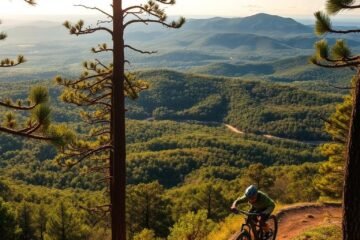
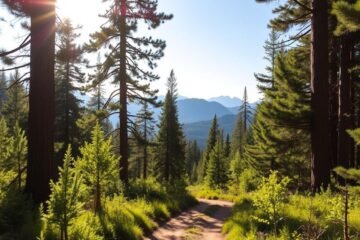
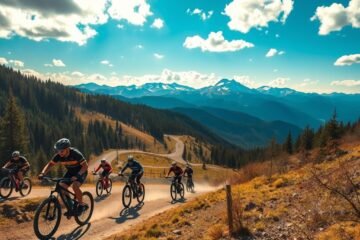
0 Comments